A Simple Aridity Index to Monitor Vineyard Health: Evaluating the De Martonne Index in the Iberian Peninsula
Abstract
1. Introduction
2. Materials and Methods
2.1. Study Area
2.2. Data Collection
2.2.1. Vineyard Area Data
2.2.2. De Martonne Climate Index
2.2.3. Vegetation Health Index
2.3. Data Processing and Contingency Analysis
3. Results
3.1. Spatial Patterns of Climatic and Vegetation Conditions in Iberian Peninsula During Spring
3.2. Interpretation of Spring Drought Conditions in Iberian Vineyards Based on VHI (1993–2022)
3.3. Contingency Analysis of VHI–DMI Agreement During Spring Across Drought Categories
4. Discussion
5. Conclusions
Supplementary Materials
Author Contributions
Funding
Data Availability Statement
Acknowledgments
Conflicts of Interest
Abbreviations
| AVHRR | Advanced Very High Resolution Radiometer |
| BT | Brightness temperature |
| CLC2018 | CORINE Land Cover 2018 |
| DMI | De Martonne Index |
| IP | Iberian Peninsula |
| NDVI | Normalized Difference Vegetation Index |
| NOAA | National Oceanic and Atmospheric Administration |
| PDO | Protected Designation of Origin |
| TCI | Temperature Condition Index |
| VCI | Vegetation Condition Index |
| VHI | Vegetation Health Index |
| VIIRS | Visible Infrared Imaging Radiometer Suite |
References
- Frankel, R.; Franḳel, R. Wine and Oil Production in Antiquity in Israel and Other Mediterranean Countries; American Schools of Oriental Research: JSOT ASOR monograph series; Sheffield Academic Press: Sheffield, UK, 1999; ISBN 978-1-85075-519-7. [Google Scholar]
- Harutyunyan, M.; Malfeito-Ferreira, M. The Rise of Wine among Ancient Civilizations across the Mediterranean Basin. Heritage 2022, 5, 788–812. [Google Scholar] [CrossRef]
- Jones, G.V.; Davis, R.E. Climate Influences on Grapevine Phenology, Grape Composition, and Wine Production and Quality for Bordeaux, France. Am. J. Enol. Vitic. 2000, 51, 249–261. [Google Scholar] [CrossRef]
- Torregrosa, L.; Vialet, S.; Adivèze, A.; Iocco-Corena, P.; Thomas, M.R. Grapevine (Vitis Vinifera L.). In Agrobacterium Protocols; Wang, K., Ed.; Springer: New York, NY, USA, 2015; Volume 2, pp. 177–194. ISBN 978-1-4939-1658-0. [Google Scholar]
- Van Leeuwen, C.; Seguin, G. The Concept of Terroir in Viticulture. J. Wine Res. 2006, 17, 1–10. [Google Scholar] [CrossRef]
- Alston, J.; Sambucci, O. Grapes in the World Economy. In The Grape Genome; Springer International Publishing: Cham, Switzerland, 2019; pp. 1–24. ISBN 978-3-030-18600-5. [Google Scholar]
- Montalvo-Falcón, J.V.; Sánchez-García, E.; Marco-Lajara, B.; Martínez-Falcó, J. Sustainability Research in the Wine Industry: A Bibliometric Approach. Agronomy 2023, 13, 871. [Google Scholar] [CrossRef]
- Estreicher, S.K. A Brief History of Wine in Spain. Eur. Rev. 2013, 21, 209–239. [Google Scholar] [CrossRef]
- Iriarte-Chiapusso, M.J.; Ocete-Pérez, C.A.; Hernández-Beloqui, B.; Ocete-Rubio, R. Vitis Vinifera in the Iberian Peninsula: A Review. Plant Biosyst.—Int. J. Deal. Asp. Plant Biol. 2017, 151, 245–257. [Google Scholar] [CrossRef]
- Lavrador Da Silva, A.; João Fernão-Pires, M.; Bianchi-de-Aguiar, F. Portuguese Vines and Wines: Heritage, Quality Symbol, Tourism Asset. Ciênc. E Téc. Vitivinícola 2018, 33, 31–46. [Google Scholar] [CrossRef]
- Santos, F.A.D.N.; Vavdinos, N.; Martinez, L.F. Avances y Perspectivas Para La Investigación Del Turismo Del Vino En Portugal. PASOS Rev. Tur. Patrim. Cult. 2020, 18, 159–170. [Google Scholar] [CrossRef]
- Fraga, H.; Malheiro, A.C.; Moutinho-Pereira, J.; Cardoso, R.M.; Soares, P.M.M.; Cancela, J.J.; Pinto, J.G.; Santos, J.A. Integrated Analysis of Climate, Soil, Topography and Vegetative Growth in Iberian Viticultural Regions. PLoS ONE 2014, 9, e108078. [Google Scholar] [CrossRef]
- Candiago, S.; Tscholl, S.; Bassani, L.; Fraga, H.; Egarter Vigl, L. A Geospatial Inventory of Regulatory Information for Wine Protected Designations of Origin in Europe. Sci. Data 2022, 9, 394. [Google Scholar] [CrossRef]
- Smith, P.; Soussana, J.; Angers, D.; Schipper, L.; Chenu, C.; Rasse, D.P.; Batjes, N.H.; Van Egmond, F.; McNeill, S.; Kuhnert, M.; et al. How to Measure, Report and Verify Soil Carbon Change to Realize the Potential of Soil Carbon Sequestration for Atmospheric Greenhouse Gas Removal. Glob. Change Biol. 2020, 26, 219–241. [Google Scholar] [CrossRef]
- FAOSTAT. FAOSTAT Statistical Database. Available online: https://www.fao.org/faostat/en/#data/QCL (accessed on 28 February 2024).
- Panagos, P.; Van Liedekerke, M.; Borrelli, P.; Köninger, J.; Ballabio, C.; Orgiazzi, A.; Lugato, E.; Liakos, L.; Hervas, J.; Jones, A.; et al. European Soil Data Centre 2.0: Soil Data and Knowledge in Support of the EU Policies. Eur. J. Soil Sci. 2022, 73, e13315. [Google Scholar] [CrossRef]
- Fraga, H.; Amraoui, M.; Malheiro, A.C.; Moutinho-Pereira, J.; Eiras-Dias, J.; Silvestre, J.; Santos, J.A. Examining the Relationship between the Enhanced Vegetation Index and Grapevine Phenology. Eur. J. Remote Sens. 2014, 47, 753–771. [Google Scholar] [CrossRef]
- Santos, J.A.; Fraga, H.; Malheiro, A.C.; Moutinho-Pereira, J.; Dinis, L.-T.; Correia, C.; Moriondo, M.; Leolini, L.; Dibari, C.; Costafreda-Aumedes, S.; et al. A Review of the Potential Climate Change Impacts and Adaptation Options for European Viticulture. Appl. Sci. 2020, 10, 3092. [Google Scholar] [CrossRef]
- Andrade, C.; Fonseca, A.; Santos, J.A.; Bois, B.; Jones, G.V. Historic Changes and Future Projections in Köppen–Geiger Climate Classifications in Major Wine Regions Worldwide. Climate 2024, 12, 94. [Google Scholar] [CrossRef]
- Jones, G.V.; Goodrich, G.B. Influence of Climate Variability on Wine Regions in the Western USA and on Wine Quality in the Napa Valley. Clim. Res. 2008, 35, 241–254. [Google Scholar] [CrossRef]
- Weiskopf, S.R.; Rubenstein, M.A.; Crozier, L.G.; Gaichas, S.; Griffis, R.; Halofsky, J.E.; Hyde, K.J.W.; Morelli, T.L.; Morisette, J.T.; Muñoz, R.C.; et al. Climate Change Effects on Biodiversity, Ecosystems, Ecosystem Services, and Natural Resource Management in the United States. Sci. Total Environ. 2020, 733, 137782. [Google Scholar] [CrossRef] [PubMed]
- Gambetta, G.A.; Herrera, J.C.; Dayer, S.; Feng, Q.; Hochberg, U.; Castellarin, S.D. The Physiology of Drought Stress in Grapevine: Towards an Integrative Definition of Drought Tolerance. J. Exp. Bot. 2020, 71, 4658–4676. [Google Scholar] [CrossRef]
- De Martonne, E. L’indice d’aridité. Bull. Assoc. Géographes Fr. 1926, 3, 3–5. [Google Scholar] [CrossRef]
- Moral, F.J.; Rebollo, F.J.; Paniagua, L.L.; García-Martín, A.; Honorio, F. Spatial Distribution and Comparison of Aridity Indices in Extremadura, Southwestern Spain. Theor. Appl. Climatol. 2016, 126, 801–814. [Google Scholar] [CrossRef]
- Claro, A.M.; Fonseca, A.; Fraga, H.; Santos, J.A. Susceptibility of Iberia to Extreme Precipitation and Aridity: A New High-Resolution Analysis over an Extended Historical Period. Water 2023, 15, 3840. [Google Scholar] [CrossRef]
- Pellicone, G.; Caloiero, T.; Guagliardi, I. The De Martonne Aridity Index in Calabria (Southern Italy). J. Maps 2019, 15, 788–796. [Google Scholar] [CrossRef]
- Krivoguz, D. Analysis of Spatial and Temporal Dynamics of Climate Aridization in Rostov Oblast in 1951–2054 Using ERA5 and CMIP6 Data and the De Martonne Index. Climate 2025, 13, 151. [Google Scholar] [CrossRef]
- Paltineanu, C.; Tanasescu, N.; Chitu, E.; Mihailescu, I.F. Relationships between the De Martonne Aridity Index and Water Requirements of Some Representative Crops: A Case Study from Romania. Int. Agrophysics 2007, 21, 81–93. Available online: http://www.international-agrophysics.org/Relationships-between-the-De-Martonne-aridity-index-and-water-requirements-nof-some,106531,0,2.html (accessed on 28 September 2025).
- Milovanović, B.; Schubert, S.; Radovanović, M.; Vakanjac, V.R.; Schneider, C. Projected Changes in Air Temperature, Precipitation and Aridity in Serbia in the 21st Century. Int. J. Climatol. 2022, 42, 1985–2003. [Google Scholar] [CrossRef]
- Santos, J.A.; Ceglar, A.; Toreti, A.; Prodhomme, C. Performance of Seasonal Forecasts of Douro and Port Wine Production. Agric. For. Meteorol. 2020, 291, 108095. [Google Scholar] [CrossRef]
- Yang, C.; Ceglar, A.; Menz, C.; Martins, J.; Fraga, H.; Santos, J.A. Performance of Seasonal Forecasts for the Flowering and Veraison of Two Major Portuguese Grapevine Varieties. Agric. For. Meteorol. 2023, 331, 109342. [Google Scholar] [CrossRef]
- Blanco-Ward, D.; Ribeiro, A.; Barreales, D.; Castro, J.; Verdial, J.; Feliciano, M.; Viceto, C.; Rocha, A.; Carlos, C.; Silveira, C.; et al. Climate Change Potential Effects on Grapevine Bioclimatic Indices: A Case Study for the Portuguese Demarcated Douro Region (Portugal). BIO Web Conf. 2019, 12, 01013. [Google Scholar] [CrossRef]
- Irimia, L.M.; Patriche, C.V.; Petitjean, T.; Tissot, C.; Santesteban, L.G.; Neethling, E.; Foss, C.; Le Roux, R.; Quénol, H. Structural and Spatial Shifts in the Viticulture Potential of Main European Wine Regions as an Effect of Climate Change. Horticulturae 2024, 10, 413. [Google Scholar] [CrossRef]
- Jones, G.V.; Alves, F. Impacts of Climate Change on Wine Production: A Global Overview and Regional Assessment in the Douro Valley of Portugal. Int. J. Glob. Warm. 2012, 4, 383–406. [Google Scholar] [CrossRef]
- Moral, F.J.; Aguirado, C.; Alberdi, V.; García-Martín, A.; Paniagua, L.L.; Rebollo, F.J. Future Scenarios for Viticultural Suitability under Conditions of Global Climate Change in Extremadura, Southwestern Spain. Agriculture 2022, 12, 1865. [Google Scholar] [CrossRef]
- Lungu, O.N.; Chabala, L.M.; Shepande, C. Satellite-Based Crop Monitoring and Yield Estimation—A Review. J. Agric. Sci. 2020, 13, 180. [Google Scholar] [CrossRef]
- Kogan, F.N. Global Drought Watch from Space. Bull. Am. Meteorol. Soc. 1997, 78, 621–636. [Google Scholar] [CrossRef]
- Kogan, F.N. Application of Vegetation Index and Brightness Temperature for Drought Detection. Adv. Space Res. 1995, 15, 91–100. [Google Scholar] [CrossRef]
- Del Rio, M.S.; Cicuéndez, V.; Yagüe, C. Characterisation of Two Vineyards in Mexico Based on Sentinel-2 and Meteorological Data. Remote Sens. 2024, 16, 2538. [Google Scholar] [CrossRef]
- Rouse, J.W.; Haas, R.H.; Deering, D.W.; Schell, J.A.; Harlan, J.C. Monitoring the Vernal Advancement and Retrogradation (Green Wave Effect) of Natural Vegetation; Remote Sensing Center, Texas A&M University: College Station, TX, USA, 1973. [Google Scholar]
- Faraslis, I.; Dalezios, N.R.; Alpanakis, N.; Tziatzios, G.A.; Spiliotopoulos, M.; Sakellariou, S.; Sidiropoulos, P.; Dercas, N.; Domínguez, A.; Martínez-López, J.A.; et al. Remotely Sensed Agroclimatic Classification and Zoning in Water-Limited Mediterranean Areas towards Sustainable Agriculture. Remote Sens. 2023, 15, 5720. [Google Scholar] [CrossRef]
- Tao, S.; Zhang, X.; Feng, R.; Qi, W.; Wang, Y.; Shrestha, B. Retrieving Soil Moisture from Grape Growing Areas Using Multi-Feature and Stacking-Based Ensemble Learning Modeling. Comput. Electron. Agric. 2023, 204, 107537. [Google Scholar] [CrossRef]
- Zeng, J.; Zhang, R.; Qu, Y.; Bento, V.A.; Zhou, T.; Lin, Y.; Wu, X.; Qi, J.; Shui, W.; Wang, Q. Improving the Drought Monitoring Capability of VHI at the Global Scale via Ensemble Indices for Various Vegetation Types from 2001 to 2018. Weather Clim. Extrem. 2022, 35, 100412. [Google Scholar] [CrossRef]
- Shahzaman, M.; Zhu, W.; Bilal, M.; Habtemicheal, B.A.; Mustafa, F.; Arshad, M.; Ullah, I.; Ishfaq, S.; Iqbal, R. Remote Sensing Indices for Spatial Monitoring of Agricultural Drought in South Asian Countries. Remote Sens. 2021, 13, 2059. [Google Scholar] [CrossRef]
- Ma, P.; Peng, J.; Zheng, J.; Liu, L.; Yu, X.; Li, W. Vegetation Health in China Is Severely Compromised by Drought, Wet and Heat Stress Events. Forests 2024, 16, 38. [Google Scholar] [CrossRef]
- Sari Astuti, I.; Abdul Gani Alfarizi, I.; Aulia Herlambang, G.; Aulia Herlambang, G.; Hartono, R.; Rahmawati Sucahyo, H.; Setiabudi Wiwoho, B. Drought Indices to Map Forest Fire Risks in Topographically Complex Mountain Landscapes. KnE Soc. Sci. 2022, 197–209. [Google Scholar] [CrossRef]
- Kogan, F. New Remote Sensing Vegetation Health Technology. In Remote Sensing Land Surface Changes: The 1981-2020 Intensive Global Warming; Kogan, F., Ed.; Springer International Publishing: Cham, Swithzerland, 2022; pp. 121–148. ISBN 978-3-030-96810-6. [Google Scholar]
- Bugalho, L.; Camara, N.; Kogan, F.N. Monitoring of Forest Fire Risk Conditions in Portugal with NOAA/NESDIS Satellite-Based Vegetation Health Index. In Advances in Forest Fire Research 2018; Imprensa da Universidade de Coimbra: Coimbra, Portugal, 2018; pp. 110–118. ISBN 978-989-26-1650-6. [Google Scholar]
- Charalampopoulos, I.; Droulia, F.; Kokkoris, I.P.; Dimopoulos, P. Future Bioclimatic Change of Agricultural and Natural Areas in Central Europe: An Ultra-High Resolution Analysis of the De Martonne Index. Water 2023, 15, 2563. [Google Scholar] [CrossRef]
- Zeng, J.; Zhou, T.; Qu, Y.; Bento, V.A.; Qi, J.; Xu, Y.; Li, Y.; Wang, Q. An Improved Global Vegetation Health Index Dataset in Detecting Vegetation Drought. Sci. Data 2023, 10, 338. [Google Scholar] [CrossRef]
- Kartal, S.; Iban, M.C.; Sekertekin, A. Next-Level Vegetation Health Index Forecasting: A ConvLSTM Study Using MODIS Time Series. Environ. Sci. Pollut. Res. 2024, 31, 18932–18948. [Google Scholar] [CrossRef]
- Beck, H.E.; Zimmermann, N.E.; McVicar, T.R.; Vergopolan, N.; Berg, A.; Wood, E.F. Present and Future Köppen-Geiger Climate Classification Maps at 1-Km Resolution. Sci. Data 2018, 5, 180214. [Google Scholar] [CrossRef] [PubMed]
- European Environment Agency. Corine Land Cover 2018 (Vector), Europe, 6-Yearly—Version 2020_20u1. 2020. Available online: https://land.copernicus.eu/en/products/corine-land-cover/clc2018 (accessed on 28 November 2024).
- Araghi, A.; Martinez, C.J.; Adamowski, J.; Olesen, J.E. Spatiotemporal Variations of Aridity in Iran Using High-Resolution Gridded Data. Int. J. Climatol. 2018, 38, 2701–2717. [Google Scholar] [CrossRef]
- National Oceanic and Atmospheric Administration Blended-VHP Vegetation Health Dataset (VIIRS/AVHRR). Available online: https://www.star.nesdis.noaa.gov/smcd/emb/vci/VH/vh_ftp.php (accessed on 15 January 2025).
- Bhuiyan, C.; Kogan, F.N. Monsoon Variation and Vegetative Drought Patterns in the Luni Basin in the Rain-Shadow Zone. Int. J. Remote Sens. 2010, 31, 3223–3242. [Google Scholar] [CrossRef]
- Keller, M.; Tarara, J.M. Warm Spring Temperatures Induce Persistent Season-Long Changes in Shoot Development in Grapevines. Ann. Bot. 2010, 106, 131–141. [Google Scholar] [CrossRef]
- Yang, C.; Menz, C.; Fraga, H.; Costafreda-Aumedes, S.; Leolini, L.; Ramos, M.; Molitor, D.; van Leeuwen, C.; Santos, J. Assessing the Grapevine Crop Water Stress Indicator over the Flowering-Veraison Phase and the Potential Yield Lose Rate in Important European Wine Regions. Agric. Water Manag. 2021, 261, 107349. [Google Scholar] [CrossRef]
- Taheri Qazvini, A.; Carrion, D. A Spatiotemporal Drought Analysis Application Implemented in the Google Earth Engine and Applied to Iran as a Case Study. Remote Sens. 2023, 15, 2218. [Google Scholar] [CrossRef]
- Vicente-Serrano, S.M.; Gouveia, C.; Camarero, J.J.; Beguería, S.; Trigo, R.; López-Moreno, J.I.; Azorín-Molina, C.; Pasho, E.; Lorenzo-Lacruz, J.; Revuelto, J.; et al. Response of Vegetation to Drought Time-Scales across Global Land Biomes. Proc. Natl. Acad. Sci. USA 2013, 110, 52–57. [Google Scholar] [CrossRef]
- Martínez-Fernández, J.; Ceballos, A. Temporal Stability of Soil Moisture in a Large-Field Experiment in Spain. Soil Sci. Soc. Am. J. 2003, 67, 1647–1656. [Google Scholar] [CrossRef]
- Quiring, S.M.; Ganesh, S. Evaluating the Utility of the Vegetation Condition Index (VCI) for Monitoring Meteorological Drought in Texas. Agric. For. Meteorol. 2010, 150, 330–339. [Google Scholar] [CrossRef]
- Liu, M.; Wang, Q.; Yi, J.; Zhang, H.; Liu, J.; Hu, W. Influence of Vegetation Type and Topographic Position on Volumetric Soil Water Content Dynamics and Similarity among Surface and Deep Soil Layers. Int. Soil Water Conserv. Res. 2023, 11, 183–196. [Google Scholar] [CrossRef]
- Jiang, Y.; Smerdon, J.E.; Seager, R.; Wang, G.; Cook, B.I.; Zheng, C.; Mankin, J.S.; Williams, A.P. The Influence of Land-Surface Conditions on the 2020–2021 Western US Drought. Water Resour. Res. 2025, 61, e2024WR038124. [Google Scholar] [CrossRef]
- Almouctar, M.A.S.; Wu, Y.; Zhao, F.; Qin, C. Drought Analysis Using Normalized Difference Vegetation Index and Land Surface Temperature over Niamey Region, the Southwestern of the Niger between 2013 and 2019. J. Hydrol. Reg. Stud. 2024, 52, 101689. [Google Scholar] [CrossRef]
- Hiep, N.V.; Thao, N.T.T.; Viet, L.V.; Luc, H.C.; Ba, L.H. Affecting of Nature and Human Activities on the Trend of Vegetation Health Indices in Dak Nong Province, Vietnam. Sustainability 2023, 15, 5695. [Google Scholar] [CrossRef]
- Finco, A.; Bentivoglio, D.; Chiaraluce, G.; Alberi, M.; Chiarelli, E.; Maino, A.; Mantovani, F.; Montuschi, M.; Raptis, K.G.C.; Semenza, F.; et al. Combining Precision Viticulture Technologies and Economic Indices to Sustainable Water Use Management. Water 2022, 14, 1493. [Google Scholar] [CrossRef]
- Fraga, H.; Santos, J.A. Daily Prediction of Seasonal Grapevine Production in the Douro Wine Region Based on Favourable Meteorological Conditions. Aust. J. Grape Wine Res. 2017, 23, 296–304. [Google Scholar] [CrossRef]
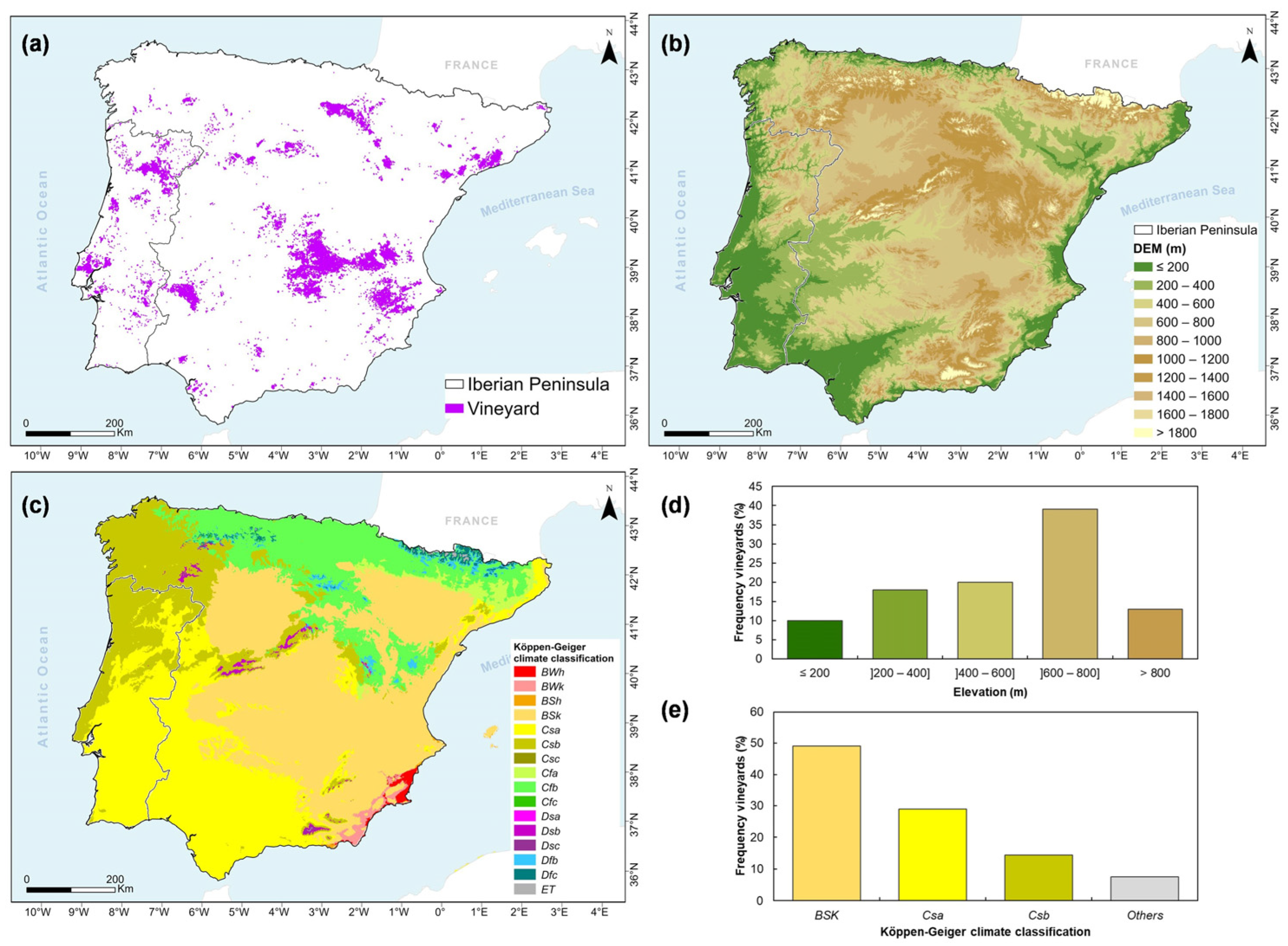
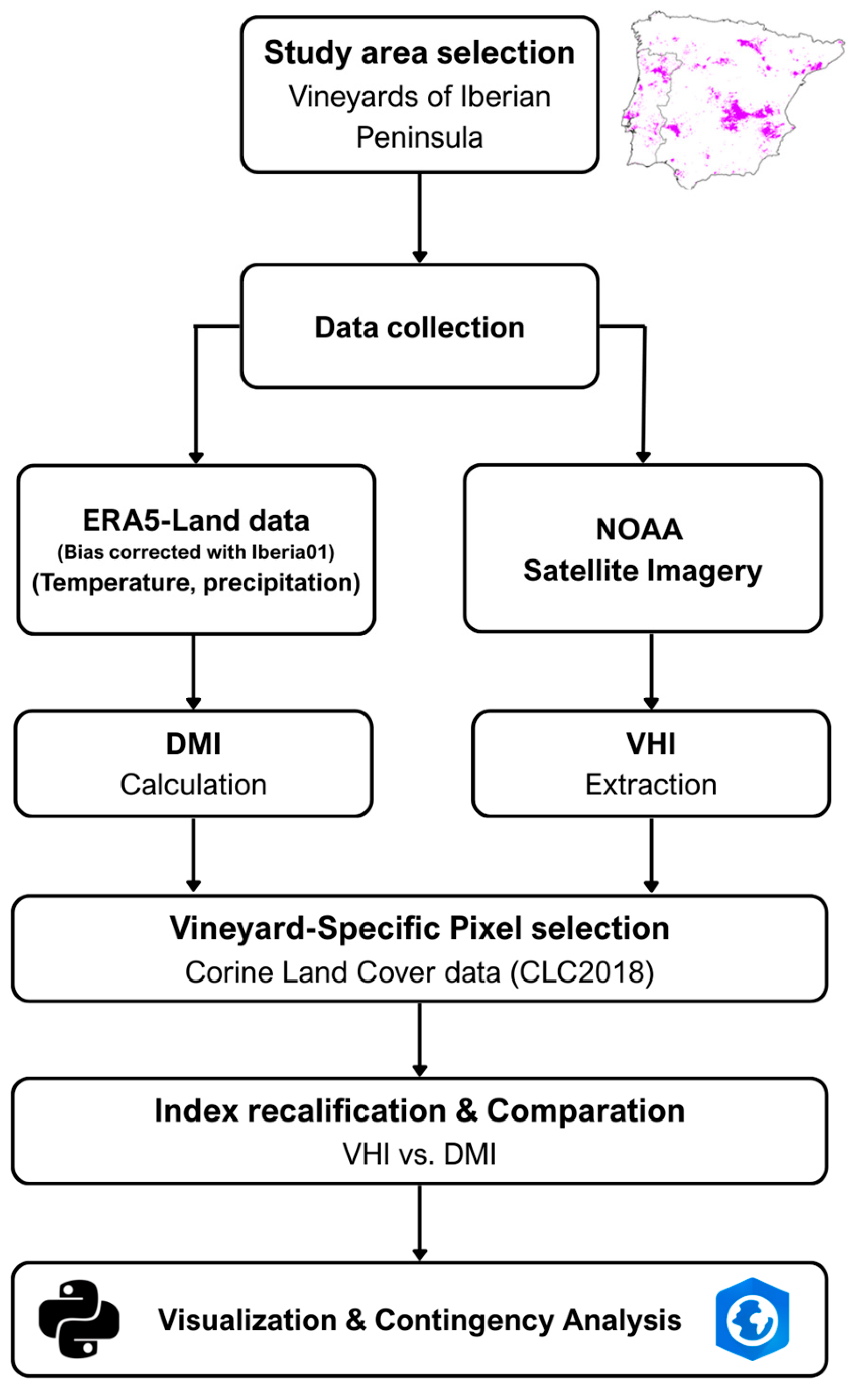
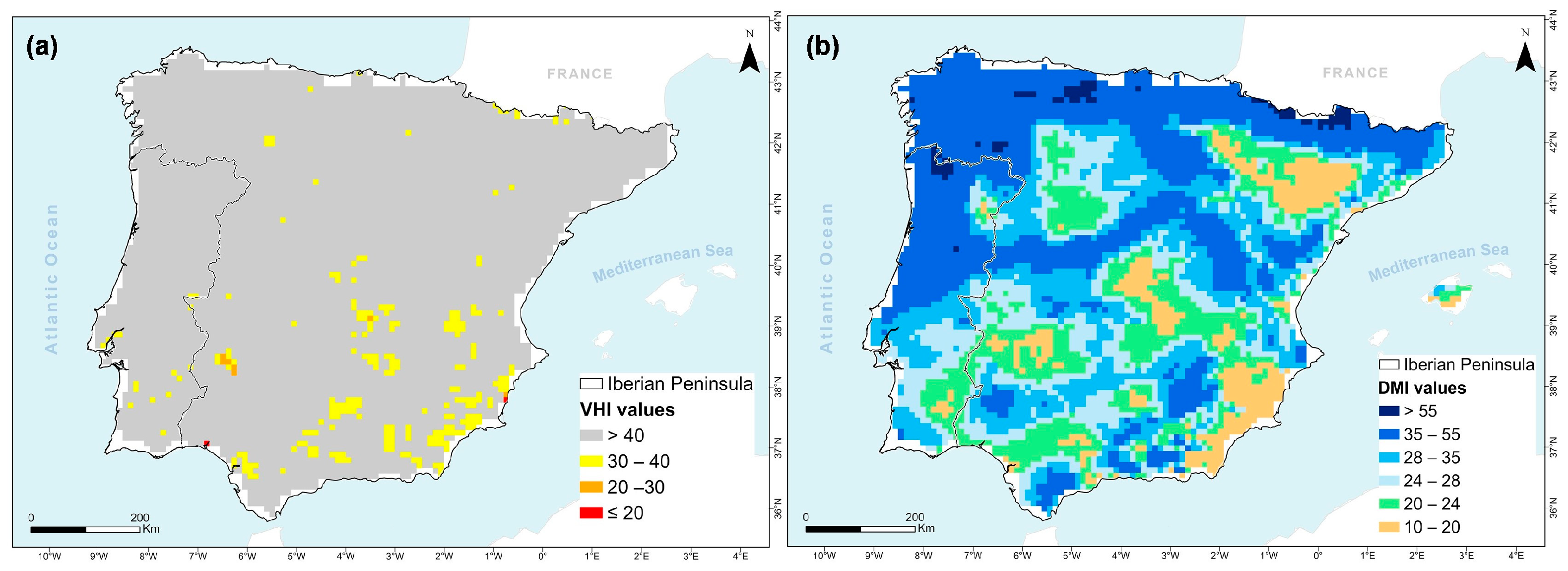
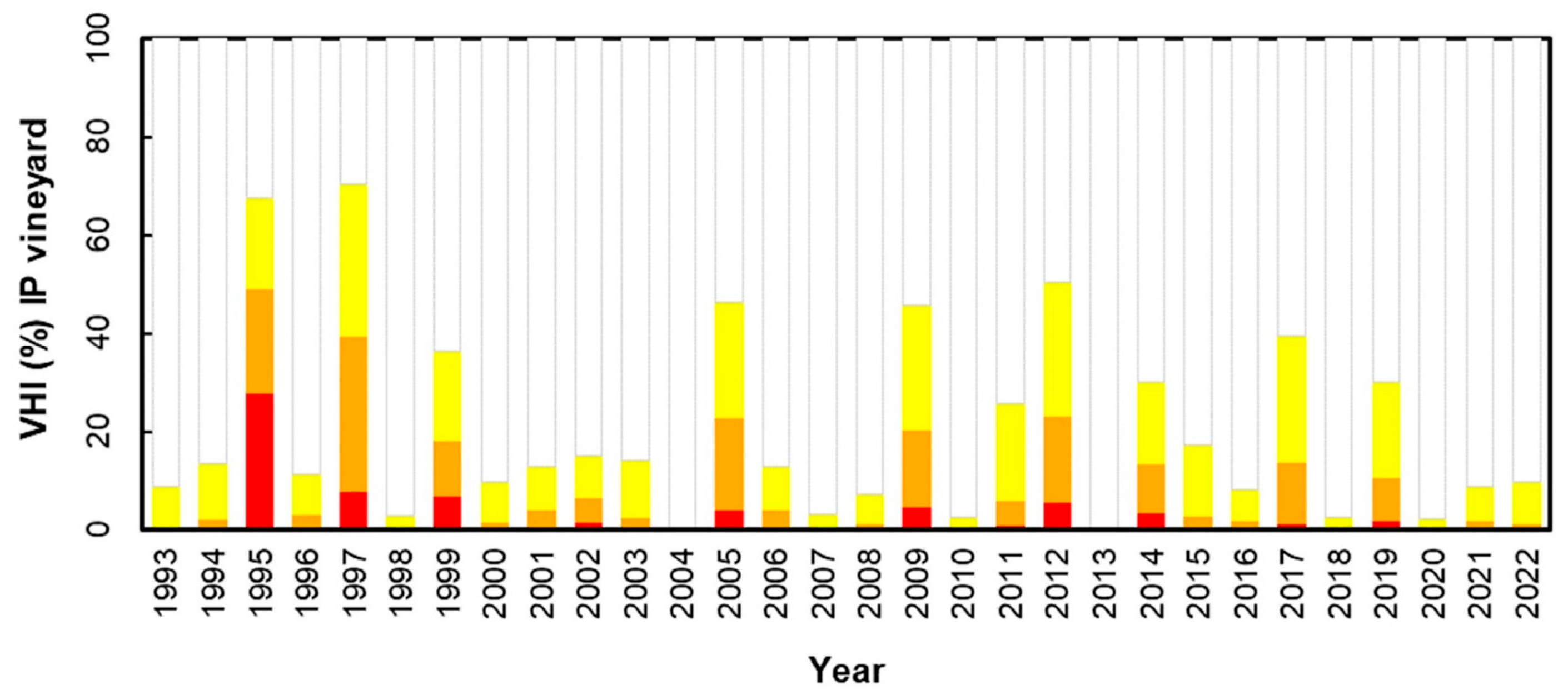
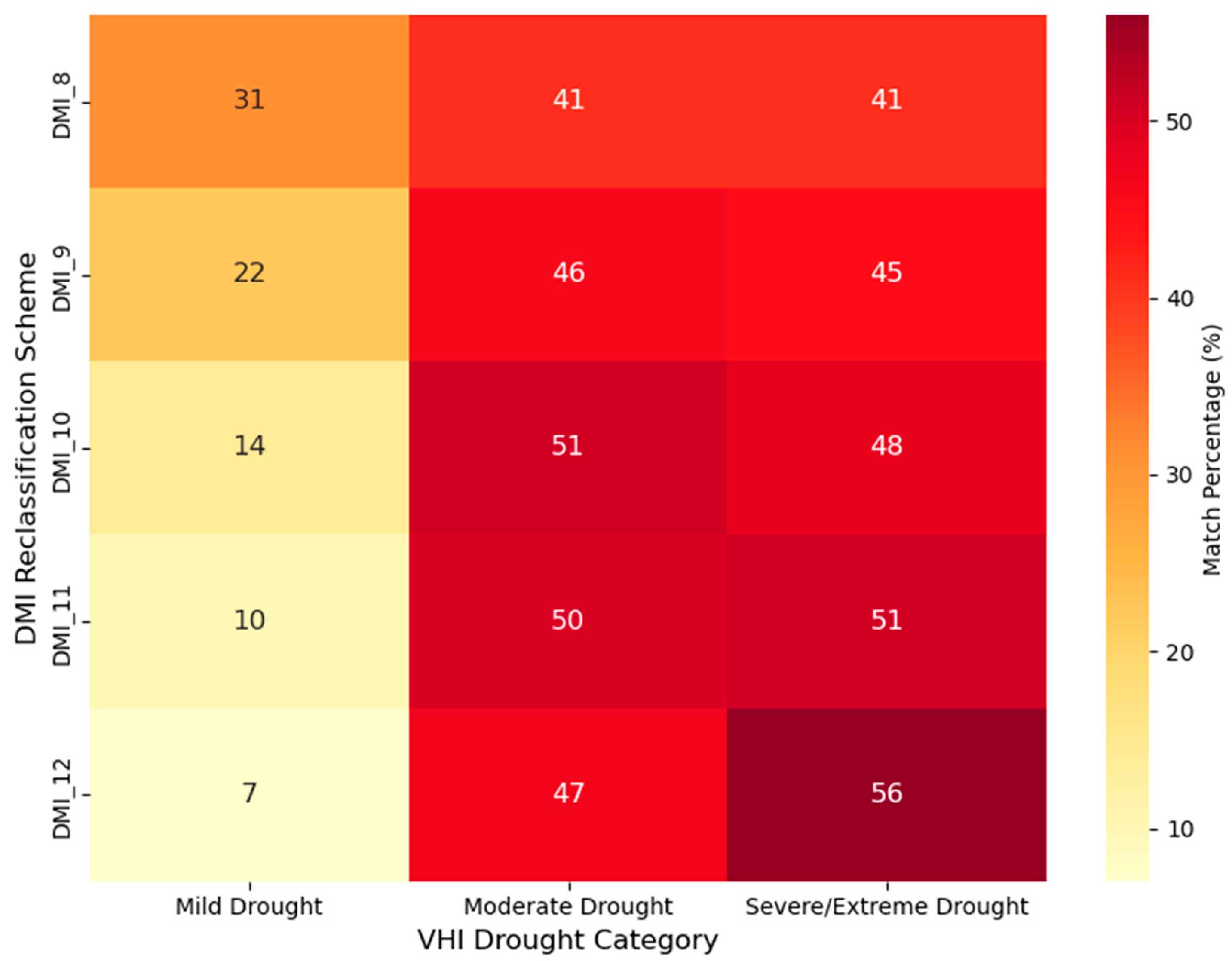
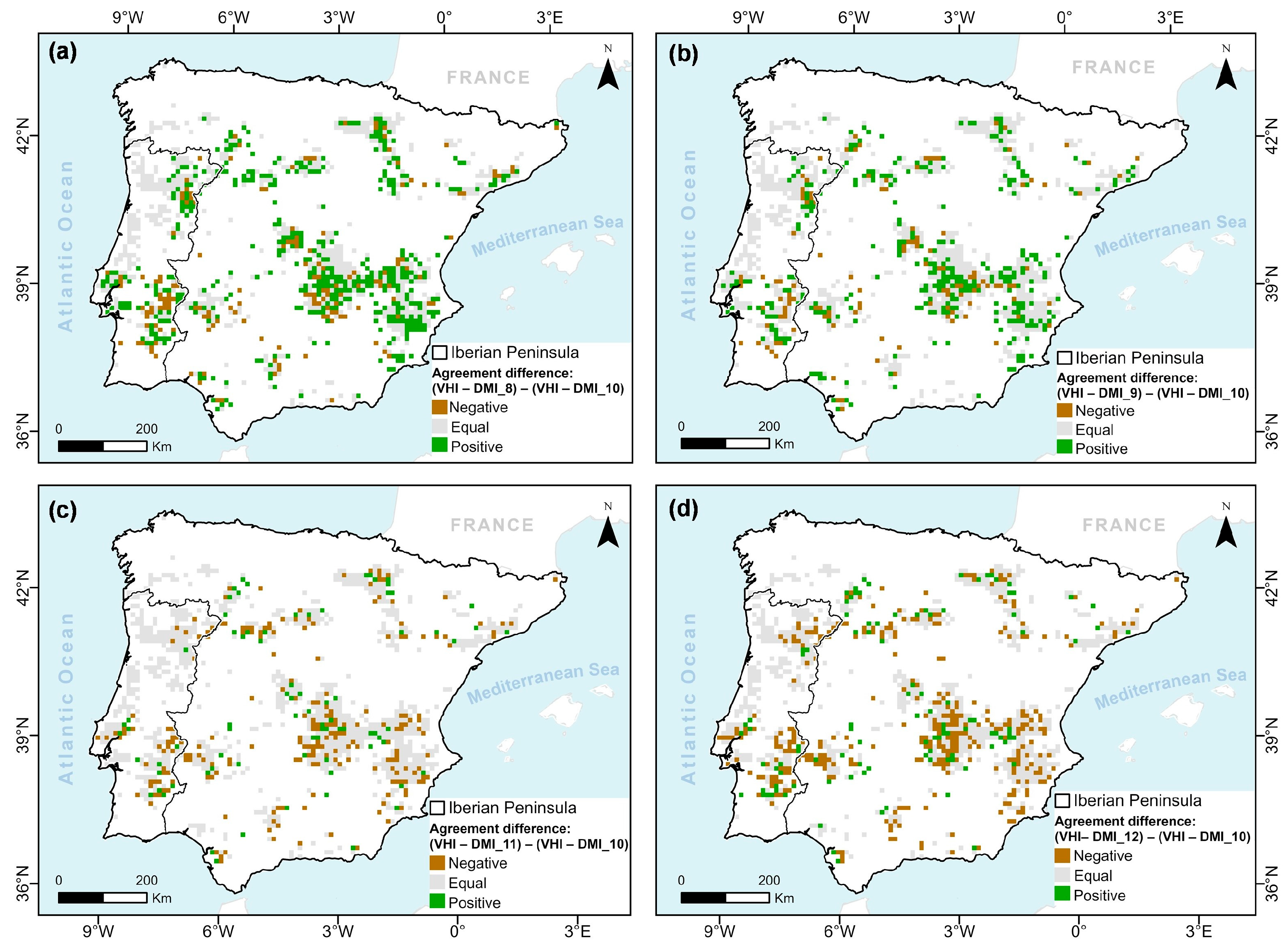

| DMI (mm/°C) | Category | Interpretation | Color Code |
|---|---|---|---|
| DMI ≥ 55 | 1 | Extremely humid | |
| 35 ≤ DMI < 55 | 2 | Very humid | |
| 28 ≤ DMI < 35 | 3 | Humid | |
| 24 ≤ DMI < 28 | 4 | Semi-humid | |
| 20 ≤ DMI < 24 | 5 | Mediterranean | |
| 10 ≤ DMI < 20 | 6 | Semi-arid | |
| 5 ≤ DMI < 10 | 7 | Arid | |
| DMI < 5 | 8 | Hyper-arid |
| VHI Values | Category | Interpretation | Color Code |
|---|---|---|---|
| VHI > 40 | 1 | No drought | |
| 30 < VHI ≤ 40 | 2 | Mild drought | |
| 20 < VHI ≤ 30 | 3 | Moderate drought | |
| 10 < VHI ≤ 20 | 4 | Severe drought | |
| VHI ≤ 10 | 5 | Extreme drought |
| VHI Values | Category | Interpretation | Color Code |
|---|---|---|---|
| VHI > 40 | 1 | No drought | |
| 30 < VHI ≤ 40 | 2 | Mild drought | |
| 20 < VHI ≤ 30 | 3 | Moderate drought | |
| VHI ≤ 20 | 4 | Severe/Extreme drought |
| DMI_8 | ||
|---|---|---|
| Value (mm/°C) | No. Values | Interpretation DMI |
| DMI > 24 | 1 | No drought/Humid conditions |
| 16 < DMI ≤ 24 | 2 | Low drought risk/Slightly dry conditions |
| 8 < DMI ≤ 16 | 3 | Moderate drought conditions |
| DMI ≤ 8 | 4 | Severe or extreme drought |
| DMI_9 | ||
| Value (mm/°C) | No. Values | Interpretation DMI |
| DMI > 24 | 1 | No drought/Humid conditions |
| 18 < DMI ≤ 24 | 2 | Low drought risk/Slightly dry conditions |
| 9 < DMI ≤ 18 | 3 | Moderate drought conditions |
| DMI ≤ 9 | 4 | Severe or extreme drought |
| DMI_10 | ||
| Value (mm/°C) | No. Values | Interpretation DMI |
| DMI > 24 | 1 | No drought/Humid conditions |
| 20 < DMI ≤ 24 | 2 | Low drought risk/Slightly dry conditions |
| 10 < DMI ≤ 20 | 3 | Moderate drought conditions |
| DMI ≤ 10 | 4 | Severe or extreme drought |
| DMI_11 | ||
| Value (mm/°C) | No. Values | Interpretation DMI |
| DMI > 24 | 1 | No drought/Humid conditions |
| 21 < DMI ≤ 24 | 2 | Low drought risk/Slightly dry conditions |
| 11 < DMI ≤ 21 | 3 | Moderate drought conditions |
| DMI ≤ 11 | 4 | Severe or extreme drought |
| DMI_12 | ||
| Value (mm/°C) | No. Values | Interpretation DMI |
| DMI > 24 | 1 | No drought/Humid conditions |
| 22 < DMI ≤ 24 | 2 | Low drought risk/Slightly dry conditions |
| 12 < DMI ≤ 22 | 3 | Moderate drought conditions |
| DMI ≤ 12 | 4 | Severe or extreme drought |
Disclaimer/Publisher’s Note: The statements, opinions and data contained in all publications are solely those of the individual author(s) and contributor(s) and not of MDPI and/or the editor(s). MDPI and/or the editor(s) disclaim responsibility for any injury to people or property resulting from any ideas, methods, instructions or products referred to in the content. |
© 2025 by the authors. Licensee MDPI, Basel, Switzerland. This article is an open access article distributed under the terms and conditions of the Creative Commons Attribution (CC BY) license (https://creativecommons.org/licenses/by/4.0/).
Share and Cite
Crespo-Cotrina, N.; Pádua, L.; Claro, A.M.; Fonseca, A.; Rebollo, F.J.; Moral, F.J.; Paniagua, L.L.; García-Martín, A.; Santos, J.A.; Fraga, H. A Simple Aridity Index to Monitor Vineyard Health: Evaluating the De Martonne Index in the Iberian Peninsula. Appl. Sci. 2025, 15, 10605. https://doi.org/10.3390/app151910605
Crespo-Cotrina N, Pádua L, Claro AM, Fonseca A, Rebollo FJ, Moral FJ, Paniagua LL, García-Martín A, Santos JA, Fraga H. A Simple Aridity Index to Monitor Vineyard Health: Evaluating the De Martonne Index in the Iberian Peninsula. Applied Sciences. 2025; 15(19):10605. https://doi.org/10.3390/app151910605
Chicago/Turabian StyleCrespo-Cotrina, Nazaret, Luís Pádua, André M. Claro, André Fonseca, Francisco J. Rebollo, Francisco J. Moral, Luis L. Paniagua, Abelardo García-Martín, João A. Santos, and Helder Fraga. 2025. "A Simple Aridity Index to Monitor Vineyard Health: Evaluating the De Martonne Index in the Iberian Peninsula" Applied Sciences 15, no. 19: 10605. https://doi.org/10.3390/app151910605
APA StyleCrespo-Cotrina, N., Pádua, L., Claro, A. M., Fonseca, A., Rebollo, F. J., Moral, F. J., Paniagua, L. L., García-Martín, A., Santos, J. A., & Fraga, H. (2025). A Simple Aridity Index to Monitor Vineyard Health: Evaluating the De Martonne Index in the Iberian Peninsula. Applied Sciences, 15(19), 10605. https://doi.org/10.3390/app151910605











